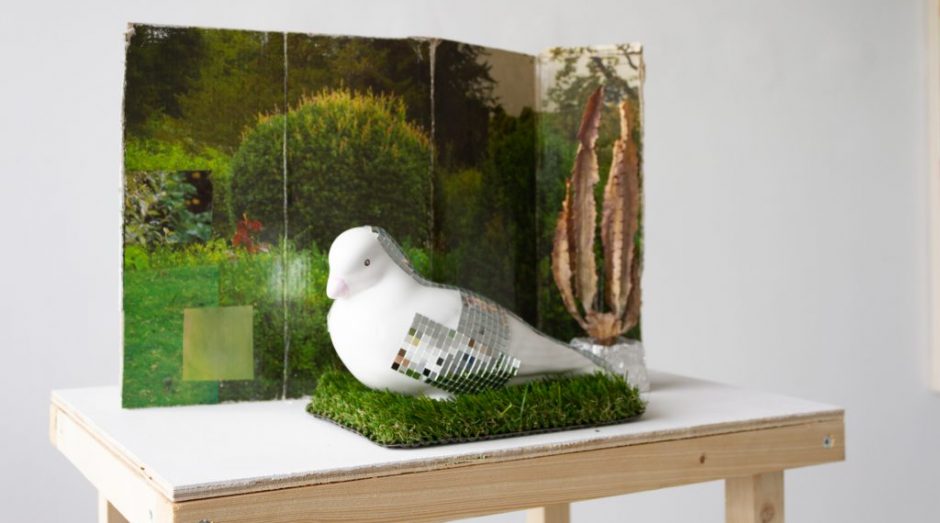
* While I forgot to take pictures from my micro-teaching lesson, here is an image from another experience of this lesson in action.
Carrier Bag Lesson and The Aesthetics of Material Storytelling
*Something to note: ahead of Wednesday’s session I was going back and forth a bit regarding the titling of this workshop. I wish that I had stuck with this original idea for the subtitle that better illustrates the objectives of the lesson. However, at the last minute I made the decision to swap out ‘The Aesthetics of Material Storytelling’ with ‘The Aesthetics of Repair’. While there are overlaps in these subtitles (around ideas of material entanglement, and care), I think the latter phrasing might have confused some folks around the objectives of the lesson.
Objectives:
-Introduce the idea of art making as communication, thinking through making / intuition, and material storytelling.
-Introduction to the idea of curation – in its expanded form.
-Consider the qualities and agency of a variety of everyday materials.
– Introduction to the idea that the ‘medium is the message’
-Create one unified object using a collection of disparate elements.
-Learn terms such as mixed media, assemblage, new materialism, montage, etc.
*There were a couple things that happened in the lead up to my workshop that meant that some of these objectives weren’t communicated properly. The first, was that I had prepared a slideshow (with notes) that in the lead up to the workshop, I decided to scrap. While in the end, we all agreed that the slides weren’t actually necessary, I do wish that I had a physical copy of my notes to refer to as I feel that this could have provided more structure and context to the session.
Materials:
Each member of the lesson will receive an envelope (carrier bag) that contains a variety of small bits of material : paper, card, wire, foil, fabric, thread, stickers, etc
*There were a few comments from participants about the success of the simplicity of the workshop’s materials. Materiality as both subject matter and medium felt ‘tangible’ in multiple senses of the word. There was a comment about how it was interesting to witness that the same set of materials could produce such radically different outcomes.
Schedule:
2:30 – 2:40pm
The lesson will start with a short slide show that will introduce ideas around the Carrier Bag Theory, New Materialism, and aesthetics of bringing things in relation to another.
*While I didn’t end up sharing the slide show, I did begin with quotes from Ursula K LeGuin’s Carrier Bag Theory of Fiction, and Jane Bennet’s Vibrant Matter. Going forward, I would like to begin with just one quote and explain a bit more (in my own words) about the context of the theory and how it will relate to what we will do in the workshop.
After the introduction of the quotes I asked the participants to spend the first five minutes creating a flat ‘graphic’ composition using all of their materials. Also at this time I asked participants to make associations /assign meaning to each piece of material that they received. Doing this workshop again, I think I would keep the association making aspect, however I think I would scrap the flattened composition task. Perhaps however, it would have been better to ask participants to share these associations out loud instead of writing silently..
2:40 – 2:45pm
Hand out the material packs. Everyone has 5 minutes to create a three dimensional object / sculpture using all of the materials in their envelope (and nothing extra).
2:45 – 2:50
Quick curation
(+ storytelling )
*There were some positive comments that were made about the general atmosphere that was generated in the workshop. Someone mentioned that there seemed to be a collapse in hierarchy that occurred during the discussions. Linda praised these moments of ‘co-teaching, and loosing of control’, where the classroom, like the sculpture became subject to chance and collaboration. There was also a comment about how physically moving about the classroom (during the curation section) can help enhance engagement and cognition for students. A final comment was that it would have been helpful to end the session with a return to the idea of storytelling. Going forward, I would like to ask each student to ‘perform’ the objects as if they were puppets / props within a performance. I would be interested to see how each story might change depending on the curation of objects in relation to one another, and also how these stories may help promote the diversity of voices within the classroom – emphasising agency and subjective meaning making systems.
